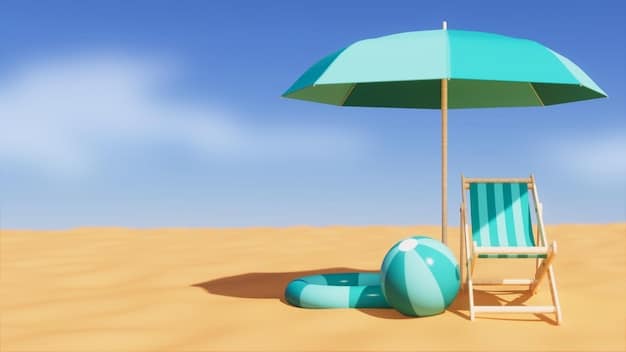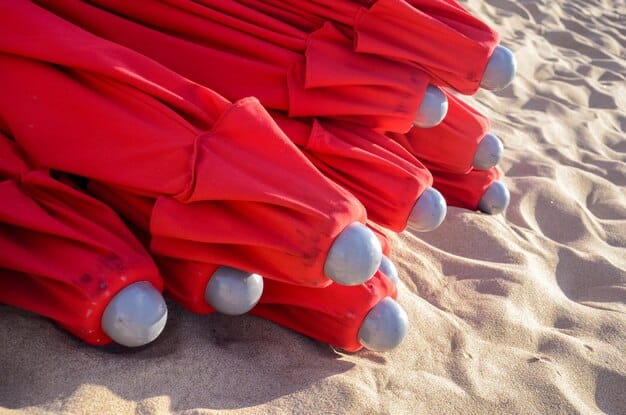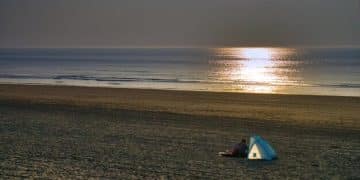Beach Umbrella Buying Guide: Size, Material, Stability for Your Perfect Day

Choosing the ideal beach umbrella involves a crucial assessment of size for adequate shade, material for UV protection and durability, and critical stability features to withstand coastal winds, ensuring a safe and comfortable beach experience.
Venturing to the beach promises relaxation and fun, but a scorching sun can quickly turn pleasure into discomfort. Understanding how to choose the right beach umbrella: size, material, and stability is paramount for maximizing your enjoyment and ensuring protection from harsh UV rays.
Understanding the Essentials of Beach Umbrella Selection
Selecting a beach umbrella might seem straightforward at first glance, but a deeper dive into its specifications reveals a nuanced decision-making process. The goal is to secure a companion that not only provides shade but also endures the unpredictable elements of a coastal environment.
Each component, from the fabric’s weave to the anchor’s design, plays a pivotal role in the umbrella’s overall performance. Neglecting these details can lead to frustration, compromised safety, or simply a lost investment at the mercy of the wind.
The Core Purpose: Shade and UV Protection
Beyond aesthetics, the primary function of any beach umbrella is to offer effective shade and adequate protection from the sun’s ultraviolet (UV) radiation. This involves not just the size of the canopy but also the fabric’s ability to block harmful rays.
- UPF Rating: Look for umbrellas with a high UPF (Ultraviolet Protection Factor) rating, similar to sunscreen, indicating its effectiveness in blocking UV radiation. A UPF 50+ rating offers excellent protection.
- Canopy Material: Polyester and nylon with special coatings are common. Look for those explicitly stating UV protection features.
- Color Choice: Darker colors tend to absorb more UV radiation but can also attract more heat. Lighter colors reflect more light and heat, potentially feeling cooler underneath.
The strategic placement of your umbrella is also crucial. As the sun shifts throughout the day, the shadow cast by the umbrella will also move. Experienced beachgoers often adjust their umbrella’s angle or position hourly to maintain optimal shade coverage.
Durability Against Elements
A beach environment is harsh, with salt, sand, and wind constantly testing equipment. The durability of a beach umbrella is directly linked to its construction and the quality of materials used. A sturdy frame and resilient fabric are non-negotiable for longevity.
The frame, often made of steel, aluminum, or fiberglass, determines much of the umbrella’s resilience. Aluminum is lightweight and corrosion-resistant, while steel offers robust strength but can be heavier and prone to rust if not properly coated. Fiberglass provides flexibility and exceptional wind resistance, making it an increasingly popular choice for ribs and poles.
Furthermore, consider the quality of the stitching and any reinforced joints. These small details can significantly impact the umbrella’s ability to withstand repeated stress from opening, closing, and windy conditions. A well-constructed umbrella often features double-stitching and robust hardware.
Finally, understand that even the most durable umbrella requires proper care. Rinsing off salt and sand after each use and allowing it to dry completely before storage can extend its lifespan considerably.
Size Matters: Ensuring Ample Shade
The dimensions of a beach umbrella directly dictate the amount of shade it can provide, a critical factor for comfort and sun protection. When assessing size, it’s not just about the canopy’s diameter but also how many people it needs to accommodate and the amount of gear it needs to cover.
Determining the Right Diameter
The umbrella’s diameter, or arc, is typically measured across the canopy when open. This measurement gives you a strong indication of the shade footprint. A larger diameter means more shaded area, which is ideal for families or groups.
- Individual Use: A 6-foot diameter umbrella is usually sufficient for one person, offering personal shade and minimal bulk for portability.
- Couples or Small Families: For two to three people, an 8-foot umbrella provides a comfortable zone, allowing space for a cooler and a few beach bags without feeling cramped.
- Groups or Large Families: If you’re heading to the beach with four or more people, or require extensive coverage for a significant amount of gear, opt for umbrellas with a 9-foot diameter or larger.
It’s important to visualize this space. An umbrella’s shade footprint shifts with the sun, so a larger canopy offers a broader margin for error, keeping you covered even as the sun’s angle changes throughout the day.
Height and Coverage Considerations
Beyond diameter, the height of the umbrella pole also impacts its effective coverage and usability. A taller pole might create a larger overall shaded area, but it also means the canopy might be higher off the ground, potentially allowing more oblique sun rays to penetrate underneath.
Adjustable height features are incredibly useful. They allow you to lower the canopy for increased sun protection during peak hours or raise it for better airflow and visibility. This adaptability enhances the umbrella’s utility across different times of the day and varying sun intensities.

Material Selection: Fabric and Frame for Longevity
The longevity and effectiveness of your beach umbrella hinge significantly on the materials used for both its canopy and frame. Quality materials offer superior protection, resistance to elements, and durability, ensuring your investment stands the test of time and many beach trips.
Canopy Fabric: Beyond Just Color
The canopy is your primary defense against the sun, and its material dictates its protective qualities and resistance to fading or tearing. Popular materials include polyester, nylon, and sometimes canvas.
- Polyester: Widely used for its durability, resistance to stretching and shrinking, and good retention of color. Look for polyester treated with a UV-resistant coating for enhanced sun protection.
- Nylon: Often lighter than polyester, nylon is also strong and quick-drying. Like polyester, it should have a UV coating for effective sun blocking.
- Canvas (Acrylic or Solution-Dyed): While heavier and more expensive, high-quality solution-dyed acrylic canvas offers exceptional fade resistance and durability, often found in premium umbrellas.
Beyond the material type, consider the fabric’s thickness and weave. A denser weave generally offers better UV protection. Water-repellent treatments are also a plus, helping shed light rain and preventing mold and mildew buildup.
The stitching of the fabric panels is another critical detail. Double-stitched seams provide greater strength and reduce the likelihood of tears under tension or during high winds. Look for designs that reinforce stress points where the fabric connects to the ribs.
Frame and Ribs: The Backbone of Stability
The frame, composed of the pole and ribs, provides the structural integrity of the umbrella. The material choice here is crucial for both durability and wind resistance.
- Steel: Offers excellent strength and is typically more affordable. However, it is heavier and susceptible to rust if not properly coated or if the coating is compromised by scratches. Ideal for stationary use or when weight is not a primary concern.
- Aluminum: Lightweight, corrosion-resistant, and strong, making it an excellent choice for a portable beach umbrella. Aluminum frames are less likely to rust, even in salty environments.
- Fiberglass: Highly flexible and durable, fiberglass ribs are exceptionally popular for their ability to flex in high winds without snapping, providing superior wind resistance compared to rigid metal ribs.
The pole’s diameter and thickness also contribute to stability. A thicker, more robust pole will stand up better to strong gusts. Furthermore, look for poles that feature a pointed tip or integrated sand anchor for easier insertion into the sand.
Some umbrellas come with a tilting mechanism, allowing you to adjust the canopy’s angle for optimal shade as the sun moves. Ensure this mechanism is robust and easy to operate, as a flimsy one can quickly break.
Stability Features: Withstanding Coastal Winds
One of the most common challenges for beachgoers is keeping their umbrella firmly planted in the sand, especially on windy days. Effective stability features are paramount for safety and preventing your umbrella from becoming a runaway projectile.
Understanding Wind Resistance
Wind is the primary adversary of any beach umbrella. An umbrella not designed to handle wind can quickly invert, snap, or become a hazard. Look for features specifically engineered to enhance wind resistance.
- Vented Canopy (Wind Vent): This is a crucial feature. A double-tiered canopy with vents allows wind to pass through the top, reducing pressure buildup underneath the umbrella and minimizing the chance of it lifting or inverting.
- Flexible Ribs: As mentioned, fiberglass ribs can flex with the wind rather than breaking, offering superior resilience compared to rigid metal ribs.
- Sturdy Pole Diameter: A wider pole provides a more stable base in the sand, less prone to swaying or bending under strong gusts.
Beyond these design elements, how you set up and anchor your umbrella significantly impacts its stability. Even the most wind-resistant umbrella can fail if not properly secured.
Consider the wind direction when setting up. Position your umbrella so the wind flows over the top rather than getting caught underneath the canopy. This often means angling it slightly into the wind, or at least observing the prevailing breeze. Proper placement reduces the initial stress on the umbrella.
Anchoring Mechanisms
The method by which you secure your umbrella into the sand is perhaps the most critical stability factor. Various anchoring solutions exist, each offering different levels of security.
- Sand Screw/Anchor: Many modern beach umbrellas come with an integrated sand screw at the base of the pole. This allows you to twist the pole deep into the sand for a firm grip. Some umbrellas come with a separate, heavy-duty sand anchor accessory that the umbrella pole then slides into.
- Auger Tip: A pointed pole end with a spiral twist (like an auger drill bit) greatly assists in digging and securing the pole into compacted sand.
- Weight Bags: For extra stability, weight bags filled with sand, water, or even small rocks can be placed over the ribs or around the base of the pole. While often sold separately, they offer a significant boost in keeping the umbrella grounded.
When using a sand screw or auger, ensure you twist it deep enough into the sand—at least 1 to 2 feet, depending on the umbrella’s size and wind conditions. The deeper and firmer the anchor, the less likely your umbrella will take flight. For very soft or loose sand, packing the sand around the base and possibly even wetting it slightly can help create a more compact and stable foundation.

Portability and Ease of Use
A great beach umbrella isn’t just about shade and stability; it also needs to be easy to transport and set up. Heavy, cumbersome umbrellas or those with complicated assembly can detract from the overall beach experience, especially when juggling family, coolers, and other beach gear.
Weight and Carry Bag Considerations
When selecting your umbrella, consider its total weight and how easy it is to carry from your vehicle to your chosen spot on the beach. Lightweight materials like aluminum or fiberglass for the pole and ribs significantly reduce the overall weight.
- Carry Bags: Most beach umbrellas come with a carry bag. Look for bags that are durable, have comfortable shoulder straps, and are roomy enough to easily pack the umbrella without a struggle. Some even feature additional pockets for small items.
- Compact Folding: Check the umbrella’s folded length. Shorter lengths are generally easier to transport in car trunks or store at home.
An overly heavy umbrella can make a short walk to the beach feel like a marathon, especially if you have other items to carry. Balance durability with portability, opting for the lightest option that still meets your stability and size requirements.
Setup and Take-Down Efficiency
The ease with which you can deploy and pack away your umbrella is a major convenience factor. During a hot day, battling with a tricky setup can be frustrating.
- Simple Mechanisms: Look for straightforward push-button or crank mechanisms for opening and closing the umbrella. Avoid complex locking systems that might pinch fingers or jam with sand.
- Integrated Anchors: Umbrellas with built-in sand anchors or auger tips simplify setup as you don’t need a separate tool to secure it. This streamlines the process and reduces the number of items you need to carry.
Consider reading reviews about setup difficulty. Some umbrellas require more brute force or specific techniques to secure, which might not be ideal for everyone. Quick and intuitive setup means more time enjoying the sand and surf.
Similarly, the take-down process should be just as efficient. An umbrella that folds up neatly and quickly is a blessing at the end of a long day when you’re tired and perhaps dealing with a sandy, wet umbrella.
Additional Features and Accessories
Beyond the core functionalities of shade, stability, and portability, many beach umbrellas come with additional features or have compatible accessories that can enhance your beach day experience. These thoughtful additions can add significant value and convenience.
Tilting Mechanisms for Dynamic Shade
A tilting mechanism is one of the most useful features. As the sun moves across the sky, your umbrella’s shadow will shift. A tilt function allows you to quickly adjust the canopy’s angle, ensuring you stay in the shade without having to move the entire umbrella.
- Push-Button Tilt: Common and easy to use, you typically push a button on the pole and tilt the canopy to the desired angle.
- Crank Tilt: Some higher-end models feature a crank handle that allows for continuous tilting, offering precise angle adjustments.
Ensure the tilting mechanism feels sturdy and locks securely in place. A wobbly tilt can be annoying and reduce the effectiveness of the shade.
Integrated Side Pockets and Hooks
Some umbrellas include practical additions right on the pole or inside the canopy:
- Storage Pockets: Mesh or fabric pockets sewn into the inner canopy can be handy for storing small items like sunglasses, keys, or a phone, keeping them out of the sand and easily accessible.
- Hanging Hooks: A simple hook on the pole can be invaluable for hanging towels, clothing, or small bags, keeping them dry and off the sand.
These features, while small, contribute significantly to convenience and organization on a busy beach day.
UV Protection and Fabric Treatments
While discussed earlier, it’s worth reiterating the importance of specific fabric treatments:
- Advanced UPF Ratings: Beyond UPF 50+, some manufacturers highlight even higher blockage rates or claim specialized fabrics that offer superior protection.
- Water-Repellent Coatings: These help the canopy shed light rain, keeping you dry during unexpected drizzles, and also prevent water absorption which can lead to mildew.
- Fade Resistance: High-quality fabrics are often treated to resist fading from prolonged sun exposure, keeping your umbrella looking vibrant season after season.
Always verify these claims on product specifications or reputable reviews. A well-treated fabric will maintain its protective and aesthetic qualities for longer.
Maintenance and Care for Beach Umbrellas
To ensure your beach umbrella continues to provide reliable shade and stands strong against the elements for many seasons, proper maintenance and care are essential. Neglecting these simple steps can lead to premature wear, rust, mold, and diminished performance.
Routine Cleaning for Longevity
The beach environment—with its sand, saltwater, and sun—is tough on materials. Regular cleaning is crucial to counteract these effects.
- Rinse Off Sand and Salt: After each use, especially if near saltwater, rinse the entire umbrella thoroughly with fresh water. Pay particular attention to the pole, ribs, and any moving parts to remove salt residue and sand grains that can cause corrosion or abrasive wear.
- Spot Clean Canopy: If the canopy gets stained, spot clean it immediately using a mild soap and water solution. Avoid harsh chemicals that could damage the fabric or strip its protective coatings.
Allow the umbrella to air dry completely before folding and storing it. Storing a damp umbrella is an invitation for mold and mildew to grow, which can not only smell unpleasant but also degrade the fabric over time. Ensure all components, especially the fabric, are bone dry before putting it away.
Proper Storage Practices
How you store your umbrella during the off-season or between beach trips significantly impacts its lifespan. Protecting it from extreme conditions and pests is key.
- Dry, Ventilated Area: Store your umbrella in a cool, dry, well-ventilated space. Basements or garages that are prone to dampness can encourage mold.
- Use the Carry Bag: Always store the umbrella in its original carry bag. This protects the fabric from dust, dirt, and potential damage, and keeps all components together.
- Avoid Direct Sunlight (When Stored): While designed for sun, prolonged exposure to direct sunlight when not in use (e.g., left on a patio uncovered for months) can accelerate fabric fading and material degradation.
Periodically inspect your umbrella for any signs of wear, such as loose screws, frayed fabric, or rust spots on metal components. Addressing small issues promptly can prevent them from becoming larger, more costly problems down the line. Tighten any loose fasteners and apply a silicone-based lubricant to moving parts if they become stiff, but avoid oil-based lubricants that can attract dirt.
Making Your Final Decision
Choosing the right beach umbrella is an investment in your comfort and sun safety. By carefully considering the factors of size, material, and stability, you can select an umbrella that not only meets your immediate needs but also provides lasting value for countless beach adventures.
Remember that the “best” umbrella is subjective; it’s the one that perfectly aligns with your specific preferences, common beach conditions you encounter, and the number of people you typically shade. Prioritizing features like a high UPF rating, a strong anchoring system, and durable, weather-resistant materials will ensure you have a reliable companion for years to come.
Ultimately, a well-chosen beach umbrella enhances your time by the ocean, transforming a potentially harsh environment into a comfortable, shaded oasis. Take the time to research, compare options, and invest in quality for a truly relaxing beach experience.
| Key Feature | Brief Description |
|---|---|
| 📏 Size | Match diameter to group size (6-9 ft+). Consider adjustable height for dynamic shade. |
| 🛡️ Material | Look for UPF 50+ polyester/nylon fabric and durable frame (aluminum/fiberglass preferred). |
| 💨 Stability | Prioritize wind vents and strong anchoring (sand screw/auger tip) for windy conditions. |
| 🚶 Portability | Opt for lightweight designs with a comfortable carry bag and simple setup mechanism. |
Frequently Asked Questions About Beach Umbrellas
▼
The most critical factor for stability is the anchoring mechanism. An umbrella with a deep-set sand screw, auger tip, or the combination of a robust pole and external weight bags provides superior resistance against powerful coastal winds, minimizing the risk of it being blown away or causing injury.
▼
The UPF (Ultraviolet Protection Factor) rating indicates how much UV radiation a fabric blocks. A UPF 50+ rating, for instance, means the fabric allows less than 1/50th (or 2%) of UV radiation to pass through, offering excellent protection. Always prioritize umbrellas with a high UPF rating for optimal sun safety.
▼
Both have advantages. Aluminum poles are lightweight and corrosion-resistant, ideal for portability. Fiberglass poles, particularly for ribs, offer superior flexibility and wind resistance as they can bend without snapping. For the main pole, a sturdy aluminum or even reinforced steel is good, but fiberglass ribs are highly recommended for windy conditions.
▼
For a family of four, an umbrella with a diameter of at least 8 to 9 feet is generally recommended. This size provides ample shade for multiple people and some beach gear, allowing everyone to comfortably escape the sun’s direct rays, even as the sun’s angle changes throughout the day.
▼
A wind vent is extremely important for beach umbrella stability. It’s a two-tiered canopy design with an opening at the top that allows wind to pass through, reducing pressure buildup beneath the umbrella. This design significantly minimizes the chances of the umbrella inverting, lifting, or breaking in strong gusts.
Conclusion
Choosing the right beach umbrella is more than just picking a color; it’s about making an informed decision that enhances your safety and enjoyment by the sea. By focusing on critical aspects such as the appropriate size for your needs, the durability and UV protection of its materials, and robust stability features to combat unpredictable winds, you can unlock a truly comfortable and worry-free beach experience. Prioritizing these elements ensures your umbrella will be a reliable shield, allowing you to relax and soak in the soothing sounds of the ocean, rather than battling the elements or fretting about sun exposure.





